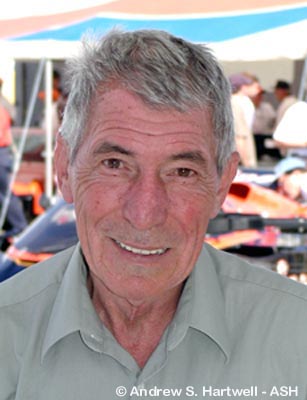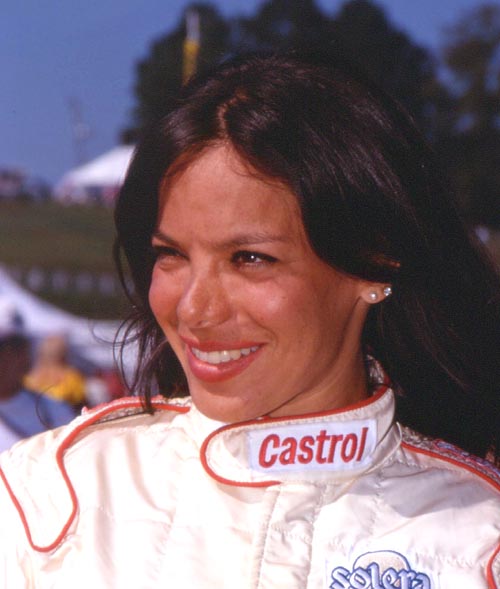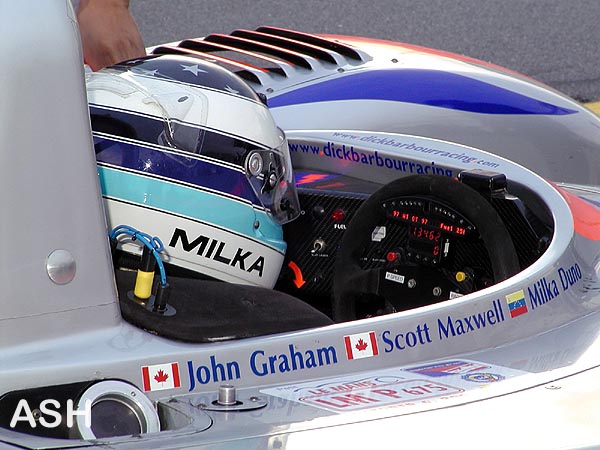This was my Through The Esses column from All Race Issue 33

Vic Elford On Milka Duno
Milka Duno's Champion Mentor
© Andrew S. Hartwell
"I've been looking after her ever since she started about two and a half years ago."
That is Vic Elford, the legendary sports car driver of Le Mans and Porsche fame, talking about his very special 'racing project', Milka Duno. Duno has been steadily taking on more challenging driving duties, progressing from Venezuelan club racing in 1996, through the Panoz Women's GT series, the Ferrari Challenge and on to a Dodge Viper in the 2000 Petit Le Mans (with Chamberlain Motorsports). She is currently running in Formula Nissan in Europe and has a seat in the Dick Barbour Racing Reynard factory LMP675 class O1Q/Judd sports prototype.
Elford comments on her current place in racing. "She is
doing wonderfully well driving the new factory Reynard
O1Q/Judd in the ALMS. And in Europe this year she is
driving Formula Nissan which are wonderful training cars
because, to my knowledge, they are the only single-seaters
apart from Formula One - that corner above 3 G's, so that is
a big, big learning curve. In Europe, Formula Nissan is now
considered the absolute last step before Formula One. The
cars are bigger and faster than Formula 3, and those cars
have pretty good downforce. It is not quite as quick as
Formula 3000 in terms of lap times, but only because F3000
cars have another 200 horsepower. Formula Nissan cars get
around corners much quicker than F3000.
"The last three champions from Formula Nissan have all gone
straight to Formula One, with no stops in between."
Formula One. Now that is a goal so many aspire to but the path can't be traveled without the right guide and the right talent. Milka Duno sees herself as having what it takes to succeed at the top. Her friend and mentor Vic Elford readily concurs.
"The first time I ever talked to Milka about where she wanted to go was in Venezuela. She said, "I want to go right to the top Vic". When I said the top is Formula One she said "Yup".
"My first comment to her was that I didn't think she would ever be strong enough. You need to be really physically strong to drive a Formula One car. And then we did some training with the Porsche Super Cup car. The cars are easy to drive but they are very physical. Well, I did about a dozen laps and when I got out I said to Milka, 'Are you sure you can drive this car?' and she gave me that wonderful smile and said, "Oh yes. No problem."
"Then she got in and it took her just 10 laps to beat my times."
And his new protégé was not finished demonstrating her strength to the man who had handled Porsche 917's before anyone else could control the beasts. "That night we went out to dinner and I said, "Now Milka, I want to see just how strong you really are." We sat at the corner of the table and arm-wrestled. You have seen her so you know she's tiny. Her arms are obviously a lot shorter than mine, so she doesn't have much leverage. I wasn't playing, but it took her literally 5 seconds to fold my arm flat on the table!
It seems Milka's arms are as powerful as the beautiful smile she wears in the paddock. But a great smile won't get you around corners any faster. And it isn't her looks that get her behind the wheel of a car owned by someone else. No, her absolute beauty lies in her ability to go fast and do it consistently. Even when she hasn't had the seat time most people need to get used to a new ride.
"In her first year, she drove in the Panoz Women's GT Series. She
didn't know any of the tracks and she had never driven that kind of
car before. Which is why I went to Venezuela to do some testing
in the Porsche Super Cup car, because I thought that was the
nearest thing I could find in size and style to the Panoz. In her first
year she finished third in the championship. She didn't do that by
going up and down every week. 40 girls started the first WGT race
and she finished 5th. I don't think she ever finished lower than 5th
or 6th, even though I had to teach her the tracks.
So Duno's consistently broad smile must be a reflection of her
driving skill. She wears the smile consistently and she drives at a
consistent pace. The latter attribute being a sought after commodity
in racing. After all, no one can see you smile when you are wearing a helmet.
"One of the keys to being a great driver is to run consistent laps, especially in long distance racing. In Formula One, they have to be able to go out and do a blinding one lap to get the pole, but, if they are really good, like both Schumacher's, Hakkinen and Montoya, they can turn the same lap times lap after lap. In endurance racing it is even more important because you will be running in traffic. When you are overtaking slower traffic, or are being overtaken by faster traffic, you still have to be able to do it.
"No question you want the more consistent man or woman - on your team. Look at the Audis. Within three laps they will be in traffic. They have got to be able to turn those consistently fast laps in slow traffic. When I was in the 917 long tail at Le Mans, I was going down the Mulsanne straight at over 245 miles per hour, which was 80 miles an hour quicker than the 911's. They were topping out at about 165. And there were a lot of 911's at Le Mans!
Elford tells the tail of Duno's first Le Mans experience, coming in this year's rain deluged event. "When the heavens opened on lap 4, she got taken out with that big crash in the esses. About five cars got together and she was right behind them so when she arrived there was no place to go so she went off and hit the guardrail."
The early departure meant she had no real driving time in the new Reynard. No time to get comfortable with the car or learn its habits and capabilities. But she has been in that position before and she has overcome the liability every time. This was never more evident than her outing in the Reynard at the Sears Point round of the ALMS.
"Sears Point was the first time she had ever had really serious practice and a serious race. She drove for an hour and a quarter in the middle of the race. One of her co-drivers was Didier de Radigues. He is very fit, having come from bikes originally, and even he was saying after about 10 laps of practice, "You really feel it. You have to work with this car." Milka said the same but she did the hour and a quarter with no problem! And she was consistently about 3 seconds quicker than her other co-driver (John Graham), lap after lap after lap."
Elford is understandably proud of his young charge. He is convinced she has what it takes to make it to the top of her chosen profession. This last recollection perhaps says it best.
"She got her first podium finish at Road Atlanta because she did the Ferrari Challenge and later on she drove the Viper for about an hour and a half before the Petit Le Mans. She had never been in anything even remotely close to the Viper in terms of size and power. The track had been closed because Porsche and Panoz were using it. They let us run about 5:00 and so she got in about 2 hours time.
"When she went out in the Viper, every single lap was quicker than the one before - every lap, from the fastest lap to the last one. "
And her last lap is some time off. So Milka Duno, smile included, will soon be moving quickly past finish lines all over North America and Europe. And one day, she could be smiling from atop a Formula One podium. Don't think she can't do it. As Vic Elford will readily testify, never bet against her talent and her desire to succeed.
And never bet against her in an arm-wrestling contest!


Updated: 8/28/2012


"A place for photos and words about sportscar racing and the people who make the cars go!"